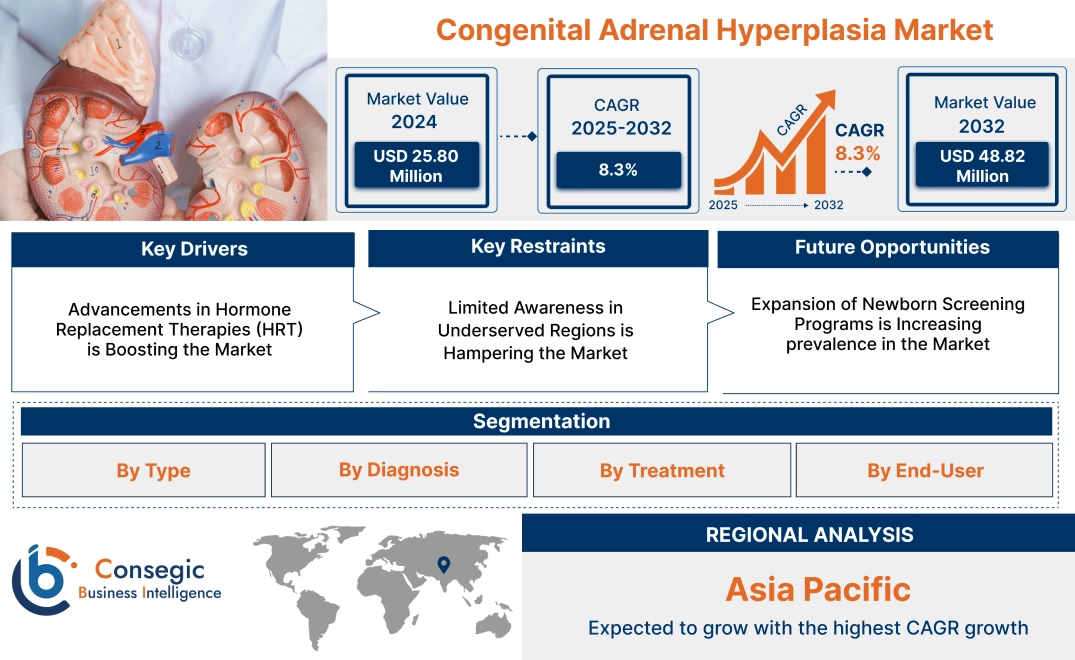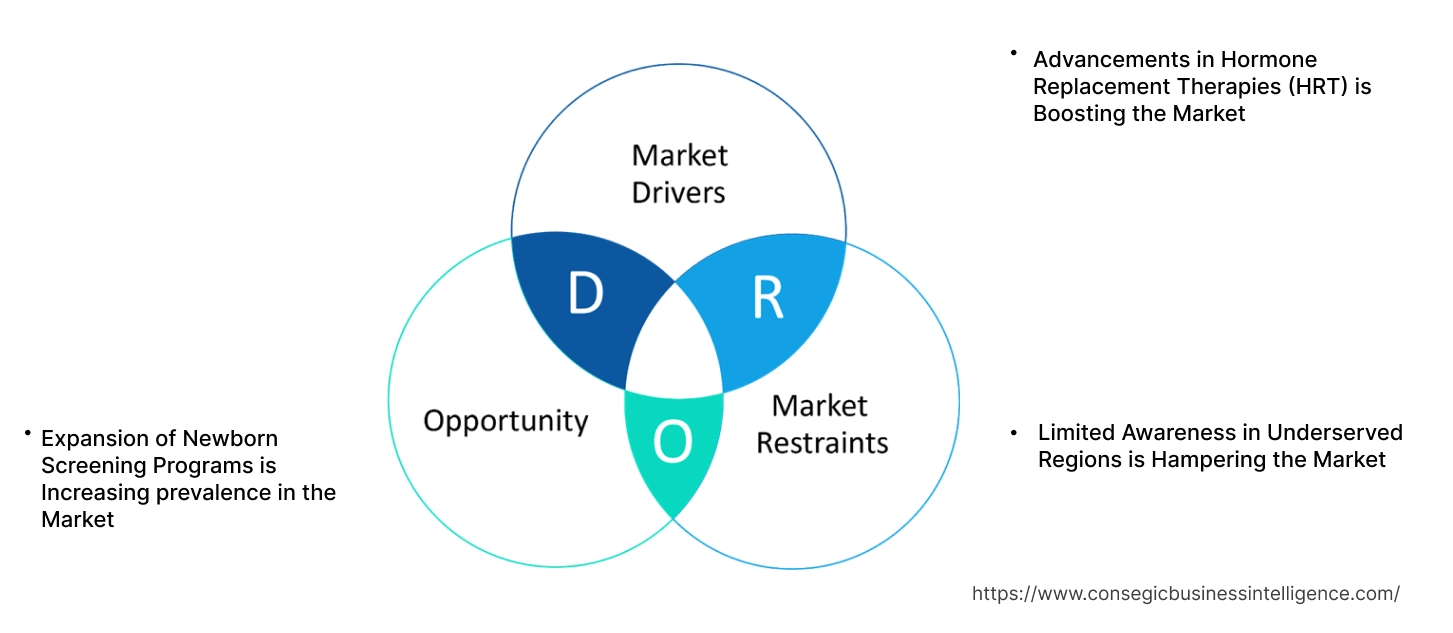Congenital Adrenal Hyperplasia Market Size:
Congenital Adrenal Hyperplasia Market size is estimated to reach over USD 48.82 Million by 2032 from a value of USD 25.80 Million in 2024 and is projected to grow by USD 27.48 Million in 2025, growing at a CAGR of 8.3% from 2025 to 2032.
Congenital Adrenal Hyperplasia Market Scope & Overview:
The congenital adrenal hyperplasia (CAH), a genetic disorder affecting the adrenal glands' ability to produce cortisol and, in some cases, aldosterone. The market encompasses pharmaceutical treatments, including glucocorticoids, mineralocorticoids, and emerging therapies targeting underlying genetic causes, as well as diagnostic tools for early detection and monitoring.
Key characteristics of CAH treatment include hormone replacement therapies tailored to individual needs, advancements in gene therapy research, and precision medicine approaches to manage symptoms effectively. The benefits include improved quality of life, normalization of hormone levels, and reduced long-term complications associated with the disorder.
Applications span hospitals, specialty clinics, and diagnostic laboratories, focusing on pediatric and adult patients managing classic or non-classic CAH. End-users include healthcare providers, endocrinologists, and patients, driven by increasing awareness of the disorder, advancements in diagnostic and therapeutic technologies, and growing investment in research targeting genetic and rare diseases.
Congenital Adrenal Hyperplasia Market Dynamics - (DRO) :
Key Drivers:
Advancements in Hormone Replacement Therapies (HRT) is Boosting the Market
Innovations in hormone replacement therapies have significantly improved the management of congenital adrenal hyperplasia (CAH). Modern formulations of glucocorticoids and mineralocorticoids are designed to provide better symptom control while minimizing side effects such as weight gain, bone density loss, and adrenal crises. Extended-release formulations, in particular, offer improved treatment adherence by reducing the frequency of daily doses, making them more convenient for patients.
Trends in precision medicine have further led to the development of personalized HRT regimens tailored to individual patient needs. Analysis underscores that these advancements not only enhance patient outcomes but also reduce the burden of long-term complications, positioning HRT as a cornerstone of CAH management.
Key Restraints:
Limited Awareness in Underserved Regions is Hampering the Market
Despite progress in diagnosing and treating CAH, limited awareness remains a significant barrier in rural and underserved regions. Many healthcare providers lack the training to recognize the symptoms of CAH, leading to underdiagnosis or delayed treatment. Additionally, patients and caregivers often lack knowledge about the importance of early intervention, resulting in avoidable complications.
Trends in global health equity and advocacy aim to bridge this gap through education initiatives and capacity-building programs. However, addressing these disparities will require sustained efforts to improve access to diagnostic tools, specialist care, and public awareness campaigns in low-resource settings.
Future Opportunities :
Expansion of Newborn Screening Programs is Increasing prevalence in the Market
The expansion of newborn screening programs represents a transformative opportunity for the congenital adrenal hyperplasia market. Early detection through these programs enables timely intervention, preventing severe complications and improving long-term health outcomes. Screening for CAH is increasingly being integrated into mandatory public health initiatives, particularly in high-income countries, setting a benchmark for global healthcare practices.
Trends in neonatal care and advancements in screening technologies, such as tandem mass spectrometry, are further enhancing the accuracy and efficiency of early diagnosis. Analysis suggests that the adoption of widespread screening programs in emerging economies could significantly reduce the burden of CAH, fostering opportunities for healthcare providers and diagnostic manufacturers alike.
Congenital Adrenal Hyperplasia Market Segmental Analysis :
By Type:
Based on type, the congenital adrenal hyperplasia (CAH) market is segmented into classic CAH (salt-wasting CAH and simple virilizing CAH) and non-classic CAH.
The classic CAH segment accounted for the largest revenue share in 2024.
- Classic CAH, particularly the salt-wasting form, is the most severe and prevalent type, necessitating early and lifelong medical intervention.
- Rising awareness about the condition and advances in newborn screening programs have improved early diagnosis and treatment rates.
- Increased adoption of glucocorticoid and mineralocorticoid therapies for managing classic CAH has reinforced its dominance in the market.
- Supportive government initiatives and funding for rare disease research are further driving segment congenital adrenal hyperplasia market growth.
The non-classic CAH segment is anticipated to register the fastest CAGR during the forecast period.
- Non-classic CAH is less severe but more common, often diagnosed later in life due to milder symptoms, driving trends for specialized diagnostics and treatments.
- Growing awareness about non-classic CAH in reproductive health and endocrinology clinics is boosting congenital adrenal hyperplasia market demand for testing and therapies.
- Advances in hormonal and genetic testing technologies are enhancing diagnostic accuracy for non-classic CAH.
- Expanding healthcare access and awareness in emerging economies are expected to fuel growth in this segment.
By Diagnosis:
Based on diagnosis, the CAH market is segmented into newborn screening tests, genetic testing, and hormonal testing (17-hydroxyprogesterone levels and cortisol levels).
The newborn screening tests segment accounted for the largest revenue in congenital adrenal hyperplasia market share in 2024.
- Newborn screening is widely implemented in developed countries to identify CAH at birth, enabling early and effective intervention.
- The increasing inclusion of CAH in national newborn screening programs globally is driving this segment’s dominance.
- Technological advancements in screening methods, such as tandem mass spectrometry, have improved sensitivity and accuracy.
- Growing awareness about the importance of early diagnosis and the enlargement of screening programs in developing regions are further supporting trends.
The genetic testing segment is anticipated to register the fastest CAGR during the forecast period.
- Genetic testing is gaining prominence for confirming CAH diagnosis and identifying carriers, especially in cases with ambiguous clinical presentations.
- Increasing adoption of next-generation sequencing (NGS) and other advanced genetic tools is enhancing diagnostic precision.
- Rising congenital adrenal hyperplasia market trends for personalized medicine and family planning in CAH patients is boosting the use of genetic testing.
- Collaboration between genetic testing companies and healthcare providers to improve access and affordability is expected to drive growth.
By Treatment:
Based on treatment, the CAH market is segmented into glucocorticoids (hydrocortisone, prednisone, dexamethasone), mineralocorticoids (fludrocortisone), adrenalectomy, and gene therapy (emerging).
The glucocorticoids segment accounted for the largest revenue share in 2024.
- Glucocorticoids are the cornerstone of CAH management, used to control adrenal androgen overproduction and reduce symptoms.
- Hydrocortisone is preferred for pediatric patients due to its safety profile, while dexamethasone and prednisone are used for older patients.
- Increasing availability of advanced formulations, such as extended-release glucocorticoids, is driving adoption.
- Rising awareness about the importance of adherence to glucocorticoid therapy for effective symptom management is supporting congenital adrenal hyperplasia market growth.
The gene therapy segment is anticipated to register the fastest CAGR during the forecast period.
- Gene therapy is an emerging treatment option offering potential curative solutions for CAH by targeting the underlying genetic mutation.
- Ongoing clinical trials and significant investments in gene-editing technologies, such as CRISPR, are driving interest in this segment.
- Increasing collaboration between biotech firms and research institutions to accelerate the development of gene therapies is boosting congenital adrenal hyperplasia market opportunities.
- Rising trends for innovative and long-term treatment options for severe forms of CAH is expected to propel this segment.
By End-Use:
Based on end-user, the CAH market is segmented into hospitals, specialty clinics, ambulatory surgical centers, and research institutes.
The hospitals segment accounted for the largest revenue in congenital adrenal hyperplasia market share of 39.80% in 2024.
- Hospitals are the primary settings for diagnosing and managing severe cases of CAH, offering multidisciplinary care.
- Availability of advanced diagnostic equipment and access to specialized endocrinologists support hospital dominance in this market.
- Rising hospital admissions for neonatal and pediatric care related to CAH are driving demand in this segment.
- Increased investments in hospital infrastructure and training programs for rare disease management are further supporting growth.
The specialty clinics segment is anticipated to register the fastest CAGR during the forecast period.
- Specialty clinics focusing on endocrinology and rare diseases offer personalized and outpatient care for CAH patients.
- Growing preference for regular follow-ups and ongoing management in specialized settings is boosting congenital adrenal hyperplasia market demand for clinic-based care.
- Expansion of specialty clinics in urban and semi-urban areas has improved access to expert care for CAH.
- Increasing collaboration between specialty clinics and pharmaceutical companies to offer advanced therapies is expected to propel congenital adrenal hyperplasia market trends.
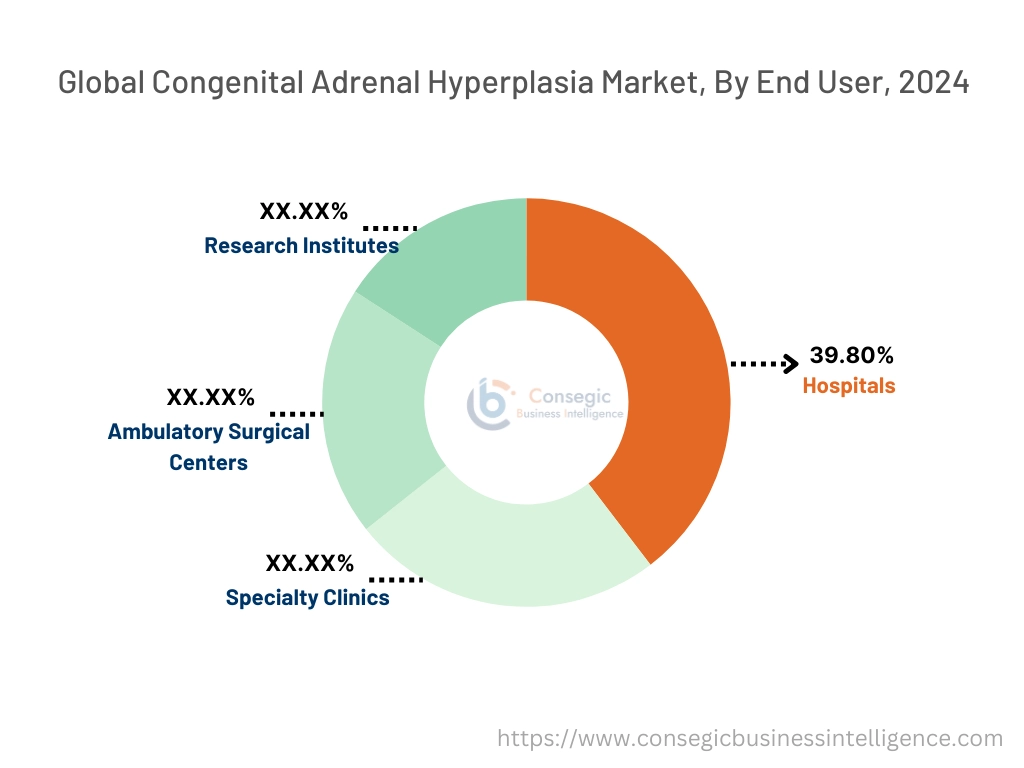
Regional Analysis:
The regions covered are North America, Europe, Asia Pacific, the Middle East and Africa, and Latin America.
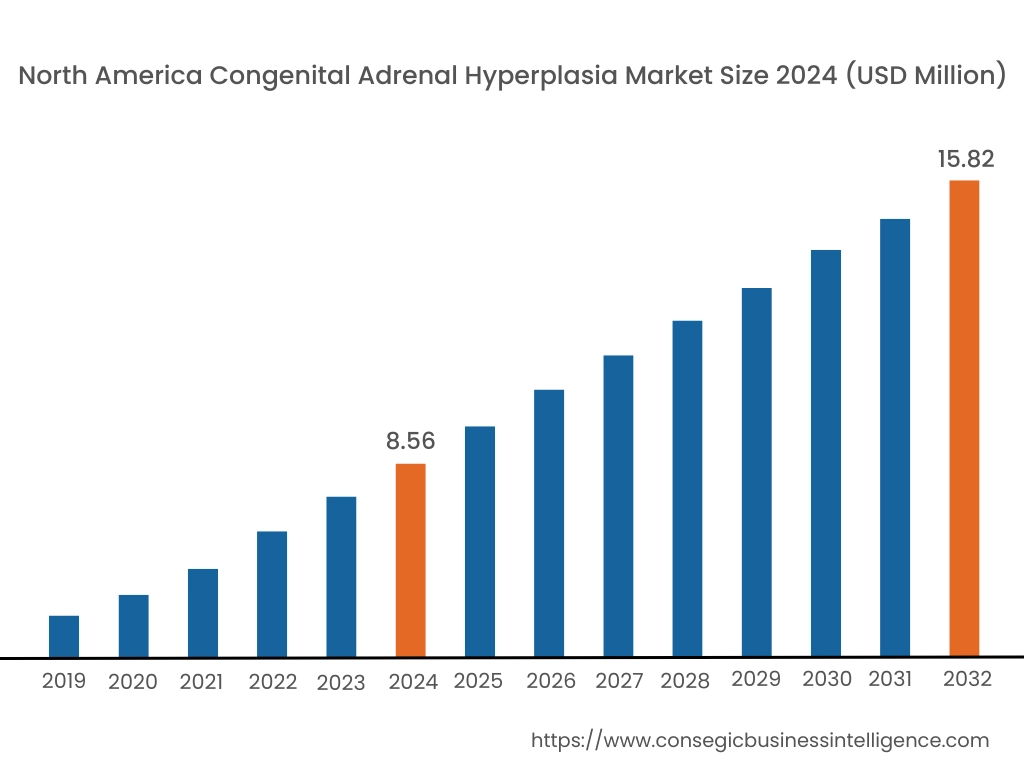
In 2024, North America was valued at USD 8.56 Million and is expected to reach USD 15.82 Million in 2032. In North America, the U.S. accounted for the highest share of 72.80% during the base year of 2024. North America holds a significant share in the global congenital adrenal hyperplasia market, driven by advanced healthcare infrastructure, high awareness about genetic disorders, and increasing availability of specialized treatments. The U.S. leads the region due to strong investments in research and development, widespread availability of corticosteroid therapies, and advanced diagnostic capabilities for early detection of CAH through newborn screening programs. As per the congenital adrenal hyperplasia market analysis, Canada contributes with growing adoption of genetic testing and increasing public health initiatives for rare disease management. However, high treatment costs and disparities in access to specialized care in rural areas may limit market growth.
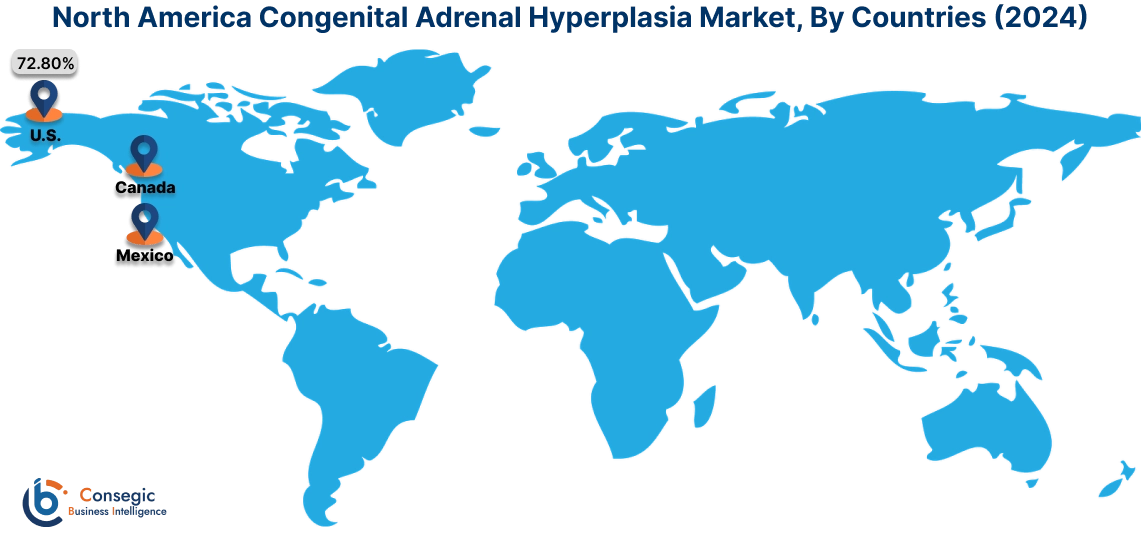
In Asia Pacific, the market is experiencing the fastest growth with a CAGR of 8.8% over the forecast period. The CAH market, is fueled by increasing awareness of genetic disorders, improving healthcare infrastructure, and growing adoption of diagnostic tools in China, India, and Japan. China dominates the region with rising adoption of newborn screening programs and increasing demand for cost-effective treatments to manage CAH. India’s expanding healthcare sector supports the adoption of corticosteroid therapies and genetic testing, particularly in urban areas. Japan emphasizes precision medicine and advanced hormonal therapies, leveraging its strong pharmaceutical and medical research capabilities. However, limited awareness and access to specialized care in rural areas may hinder congenital adrenal hyperplasia market expansion in certain parts of the region.
Europe is a prominent market for CAH, supported by a well-established healthcare system, rising awareness about endocrine disorders, and robust newborn screening programs. Countries like Germany, France, and the UK are key contributors. Germany leads the market with advanced diagnostic facilities and access to innovative treatments such as hormonal replacement therapies. France emphasizes public health campaigns and increasing availability of medications to manage CAH effectively. The UK focuses on expanding research in gene therapies and clinical trials for congenital adrenal hyperplasia. However, budget constraints in public healthcare systems may limit access to advanced therapies in certain regions.
The Middle East & Africa region is witnessing steady growth in the CAH market analysis, driven by increasing investments in healthcare infrastructure and rising awareness about genetic disorders. Countries like Saudi Arabia and the UAE are adopting newborn screening programs and advanced hormonal therapies to manage CAH effectively in pediatric and adult populations. In Africa, South Africa is emerging as a key market, focusing on improving access to diagnostics and medications for rare diseases. However, limited healthcare infrastructure and reliance on imports for advanced treatments may restrict broader market development in certain parts of the region.
Latin America is an emerging market for congenital adrenal hyperplasia, with Brazil and Mexico leading the regional analysis. Brazil’s growing healthcare sector and increasing adoption of newborn screening programs drive demand for early diagnosis and management of CAH. Mexico focuses on improving access to corticosteroid therapies and raising awareness about genetic disorders through public health initiatives. The region is also exploring partnerships with international organizations to enhance healthcare access for rare diseases. However, economic instability and inconsistent healthcare policies may pose challenges to market expansion in smaller economies.
Top Key Players and Market Share Insights:
The congenital adrenal hyperplasia market is highly competitive with major players providing products to the national and international markets. Key players are adopting several strategies in research and development (R&D), product innovation, and end-user launches to hold a strong position in the congenital adrenal hyperplasia market. Key players in the congenital adrenal hyperplasia industry include -
- Pfizer Inc. (United States)
- Novartis AG (Switzerland)
- Sun Pharmaceutical Industries Ltd. (India)
- AbbVie Inc. (United States)
- Recordati Rare Diseases Inc. (Italy)
- Sanofi S.A. (France)
- Hikma Pharmaceuticals PLC (United Kingdom)
- Bristol Myers Squibb (United States)
- Teva Pharmaceutical Industries Ltd. (Israel)
- Endo International plc (Ireland)
Recent Industry Developments :
Approvals:
- In December 2024, the U.S. Food and Drug Administration (FDA) approved Neurocrine Biosciences' drug, Crenessity (crinecerfont), for the treatment of classic congenital adrenal hyperplasia (CAH) in adults and pediatric patients aged 4 years and older. Crenessity is designed to be used alongside glucocorticoids to help control androgen levels in individuals with CAH. This approval was based on clinical trials demonstrating that patients receiving Crenessity were able to reduce their daily glucocorticoid doses while maintaining controlled androgen levels.
- In December 2024, the U.S. FDA approved Crenessity (crinecerfont), developed by Neurocrine Biosciences, as the first new treatment for classic congenital adrenal hyperplasia (CAH) in over 70 years. Approved for patients aged 4 and older, Crenessity reduces excessive adrenal androgen production, enabling lower glucocorticoid doses while maintaining control of androgen levels. The approval was based on trials involving 182 adults and 103 children with CAH. Adults on Crenessity reduced glucocorticoid doses by 27% while controlling androgen levels, and children showed significant reductions in serum androstenedione levels, a key androgen marker.
Congenital Adrenal Hyperplasia Market Report Insights :
| Report Attributes | Report Details |
| Study Timeline | 2019-2032 |
| Market Size in 2032 | USD 48.82 Million |
| CAGR (2025-2032) | 8.3% |
| By Type |
|
| By Diagnosis |
|
| By Treatment |
|
| By End-Use |
|
| By Region |
|
| Key Players |
|
| North America | U.S. Canada Mexico |
| Europe | U.K. Germany France Spain Italy Russia Benelux Rest of Europe |
| APAC | China South Korea Japan India Australia ASEAN Rest of Asia-Pacific |
| Middle East and Africa | GCC Turkey South Africa Rest of MEA |
| LATAM | Brazil Argentina Chile Rest of LATAM |
| Report Coverage |
|
Key Questions Answered in the Report
What is the estimated size of the Congenital Adrenal Hyperplasia Market by 2032? +
Congenital Adrenal Hyperplasia Market size is estimated to reach over USD 48.82 Million by 2032 from a value of USD 25.80 Million in 2024 and is projected to grow by USD 27.48 Million in 2025, growing at a CAGR of 8.3% from 2025 to 2032.
What drives the growth of the Congenital Adrenal Hyperplasia Market? +
Key drivers include advancements in hormone replacement therapies (HRT), the expansion of newborn screening programs, and increasing awareness about genetic disorders. Innovations such as extended-release glucocorticoids and advancements in diagnostic tools are further propelling market growth.
What are the major challenges in the market? +
Limited awareness about CAH, particularly in underserved and rural regions, poses a significant challenge. Delayed diagnosis and a lack of access to specialized care often hinder timely intervention and effective management.
Which segment dominates the market by type? +
The Classic CAH segment, particularly the salt-wasting form, holds the largest revenue share due to its severity and the need for early and lifelong medical intervention.
Which segment is expected to grow the fastest? +
The Non-Classic CAH segment is anticipated to register the fastest CAGR, driven by increasing awareness, advanced diagnostics, and rising demand for specialized treatments.
